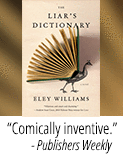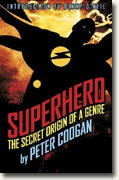Superhero
Peter Coogan
book reviews:
· general fiction
· chick lit/romance
· sci-fi/fantasy
· graphic novels
· nonfiction
· audio books
· author interviews
· children's books @
curledupkids.com
· DVD reviews @
curledupdvd.com
newsletter
win books
buy online
links
home
for authors
& publishers
for reviewers

 |
Superhero: The Secret Origin of a Genre Peter Coogan MonkeyBrain Books Paperback 290 pages July 2006 |
|
Within five years of Superman’s appearance in Action Comics #1 in 1938, he was recreated in other media including a radio show, a novel, and a series of cartoon shorts. Peter Coogan argues that Superman’s appearance in comic books didn’t just make him the symbol of comic books, justice, and the American Way, but also almost single-handedly established a new genre, a self-proclaimed “superhero” genre.
Coogan proposes that the conventions of the superhero rely mainly on a few core concepts: mission, powers, identity, and supervillains. The mission must be altruistic or socially beneficial in some sense, while the powers (or pretense of powers) must be beyond the range of human capability. The superhero must maintain some dual-identity in an attempt to protect himself (or herself) and loved ones. And every superhero needs a good supervillain to battle against. Granted, not all superheroes perfectly meet these criteria, but Coogan goes to great lengths to explain why exceptions can be made. From there, Coogan looks at the epic and mythic origins of superheros going back to Gilgamesh, Beowulf, and the like, as many others have before him have done. But Coogan breaks down new barriers in his exploration of 19th and early 20th-century manifestations of heroes and potential superheroes. Granted, he debunks the vast majority of them, including Shelley’s Frankenstein, characters from H.G. Wells, the Shadow, the Phantom, and even Philip Wylie’s Hugo Danner (the archetype for Superman). Coogan establishes many of these precursors as “science-fiction superheroes” as they are more exploratory “what-ifs” of understanding super-powered people more than a superhero being an accepted fact and exploring the world. He then goes into the various stages of the genre and its evolution from prototype to the current standards of the genre. His text provides only a few drawbacks. He does not maximize the use of his conclusions, often leaving them as a simple paragraph or two summarizing the previous chapter. Often, when he starts concentrating on a particular point or concept, he relies too strongly on examples from Marvel Comics or DC Comics, but usually not a fair mix of both. The drawback with this is that readers may have familiarity with one and not the other. Overall, Coogan makes a strong case for the genre of “superhero” that includes a significant amount of sources besides comic books and books about comics. His literary analysis and ability to bring his research together so cohesively is a true academic feat. His prose also demands notice, for he puts together a rather elaborate and technical case but manages to keep it interesting and flowing smoothly. Originally published on Curled Up With A Good Book at www.curledup.com. © Lance Eaton, 2006 |
|
|
|
 Click here to learn more about this month's sponsor! |
|
| fiction · sf/f · comic books · nonfiction · audio newsletter · free book contest · buy books online review index · links · · authors & publishers reviewers |
|
| site by ELBO Computing Resources, Inc. | |
 Coogan steps back from comic books and identifies the concept of the superhero, labeling its constructs to resemble that of a genre much like Westerns, science-fiction, or horror. Coogan considers the fact that superheroes do not solely reside in comic books. In fact, most other media have incorporated the superhero, whether it is adapted straight from comic books (movies such as The Fantastic Four and X-Men) or created specifically for the medium (the movie The Incredibles or the book The Amazing Adventures of Kavalier and Clay).
Coogan steps back from comic books and identifies the concept of the superhero, labeling its constructs to resemble that of a genre much like Westerns, science-fiction, or horror. Coogan considers the fact that superheroes do not solely reside in comic books. In fact, most other media have incorporated the superhero, whether it is adapted straight from comic books (movies such as The Fantastic Four and X-Men) or created specifically for the medium (the movie The Incredibles or the book The Amazing Adventures of Kavalier and Clay).